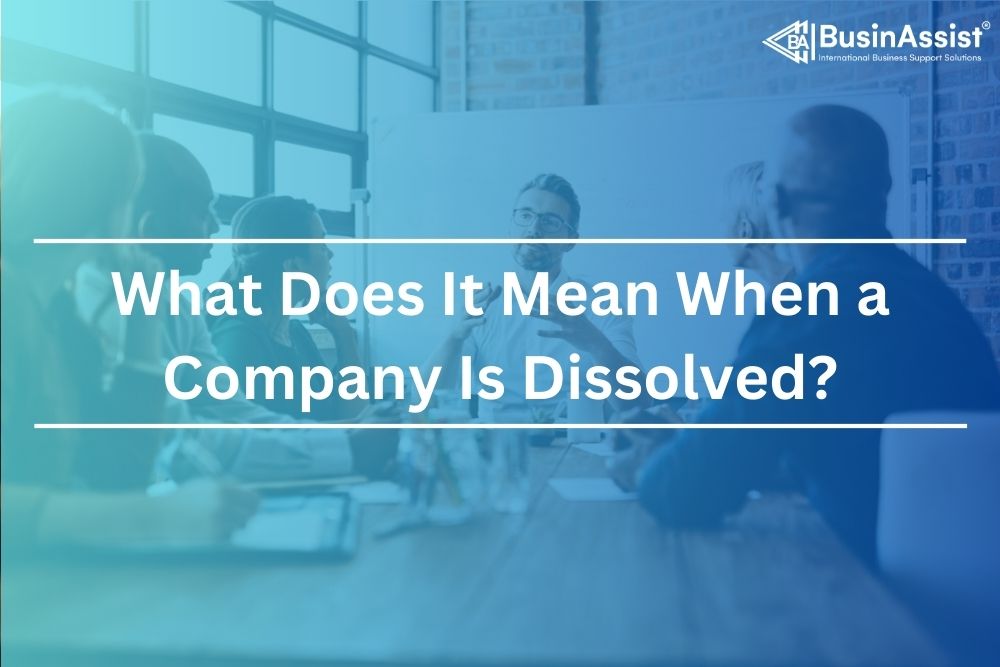Last Updated on March 28, 2025 by Joy Kyalo

The decision to close down a company is not always easy and one should make careful considerations whatever the reason for the closure is.
What does it mean when a company is dissolved? Dissolving a UK limited company refers to the process of removing or striking it off the Companies House register. A company can be dissolved for various reasons, such as bankruptcy, failure to file required documents, or a decision by the owners to close the business.
If you are thinking of dissolving your limited company, read the article to find out how to dissolve a company and whether HMRC can still pursue a dissolved company.
Is dissolving a company the same as liquidation?
Dissolution and liquidation are different in their process. Dissolving a company is a voluntary way of shutting down a UK limited company whereas liquidation is closing down a company and distributing its assets to creditors.
Why dissolve a limited company?
A company can be dissolved due to:
Business closure: If the company is no longer profitable or sustainable, dissolution allows for an orderly closure.
Retirement or exit: Owners may choose to retire or exit the business, leading to dissolution.
Change in direction: If the company’s goals or market conditions change significantly, dissolution might be necessary.
Financial difficulties: Insurmountable debts or financial challenges can prompt dissolution.
Mergers or acquisitions: Companies involved in mergers or acquisitions may dissolve to facilitate the process.
Legal compliance: Dissolution ensures compliance with legal requirements when winding up a business.
What are the types of company dissolution?
Voluntary dissolution: If a company can pay its bills, it can alternatively close down through voluntary strike off. This is the most cost-effective solution. Company directors can apply to dissolve the company voluntarily.
The company may also apply for a voluntary strike-off if the company is a subsidiary whose name is no longer needed.
Companies that are no longer trading can choose to apply for strike-off as well.
To close your company voluntarily you must submit a DS01 form. To deregister using form DS01, the company must not:
- Have traded in the last 3 months
- Have not entered into an agreement with creditors, such as a Company Voluntary Arrangement (CVA)
- Altered its name in the last 3 months
Involuntary dissolution: When your company is unable to pay its bills, the interests of creditors take priority over those of directors or shareholders. You have several options:
- Administration: Put your company into administration.
- Striking off: Request Companies House to remove your company from the register
- Creditors’ Voluntary Liquidation: Arrange for a creditors’ voluntary liquidation.
Assets may be liquidated to pay off creditors before the company is closed. There are different types of liquidation, but creditors’ voluntary liquidation (CVL) is the most common type used when the directors of the company resolve by themselves that the company should cease to exist due to insolvency.
What to do once a company is dissolved?
Hold a Board Meeting and Pass a Resolution: Begin by holding a board meeting and passing a resolution to dissolve the company. Once shareholders approve the decision, proceed to the next steps.
File Articles of Dissolution: File articles of dissolution or a similar document with the state where your company was incorporated. This formalizes the dissolution process.
Wind-Up operations: Cease business operations and liquidate any remaining assets. Liquidation involves selling non-cash assets and converting them to cash.
Settle debts and taxes: Repay outstanding debts, claims, and taxes. Ensure all financial obligations are resolved.
Shareholder distribution: Distribute any surplus funds among the shareholders. The impact on shareholders depends on the company’s financial position—they may receive their original investment back, nothing, or even be required to pay if the company becomes insolvent.
Can a company still operate if dissolved?
Once a company is legally dissolved, it cannot continue its regular business operations. However, there are a few exceptions:
Winding-up period: After dissolution, there’s usually a winding-up period during which the company settles its affairs. This includes paying off debts, distributing assets, and handling any remaining legal matters.
Limited activities: Some jurisdictions allow a dissolved company to engage in limited activities necessary for winding up. For example, it might complete existing contracts, collect outstanding payments, or transfer assets.
Specific purposes: In certain cases, a dissolved company can continue to operate for specific purposes. For instance:
- Legal proceedings: It may need to defend itself in ongoing legal proceedings.
- Tax filings: To fulfill tax obligations, including filing tax returns.
- Asset liquidation: If the company still holds assets, it can sell or distribute them.

Can HMRC pursue a dissolved company?
HM Revenue & Customs (HMRC) can pursue a dissolved company for up to six years from the date of dissolution. However, if they suspect fraud or negligence by the directors, they can extend this period to 20 years.
Dissolution is appropriate for solvent companies that are debt-free. If you dissolve a company with tax debts, HMRC can apply to reinstate the company and thoroughly review its affairs and how the directors conducted themselves while operating the business.
What to do before a company is dissolved?
Before you close down your limited company, there are things you should do such as:
- Inform all interested parties about the closure. Inform your employees of the closure after the founders and the board have agreed.
- Pay outstanding debts.
- Distribute company assets to shareholders according to their shares.
- Complete the last tax return to HMRC.
- Report payments to contract workers.
What are the steps to dissolve a company with BusinAssist?
If you’re considering dissolving a company, BusinAssist offers a complete service at a very low cost to close a UK registered company with all relevant guidance. provided to the directors during the dissolution process. Our service not only includes the submission of your company closure (dissolution) application but also includes communicating with Companies House on your behalf to address any queries they may have.
Once the application is accepted by Companies House the company dissolution process takes a minimum of 8 weeks to complete. During this period Companies House ensures that there are no objections from any relevant/interested parties to your company dissolution.
We will also allow you to use our address as the company’s registered address for free during the dissolution process. If you are an existing virtual office London customer, we will allow you to use our address for free once your existing virtual office subscription expires.
Customers who do not have UK virtual office subscriptions with us and wish to use our address as their company’s registered office address and correspondence address during the dissolution process can email us after making the order and we will allocate you with a unique address for your company.
If you have missing documents or codes from Companies House, we will even help you to get them for free at no additional cost.
If needed, we can also help you dissolve your company offline using a paper application. This involves preparing all necessary documents and sending them to Companies House on your behalf.
For more information, contact us at info@businassist.com.
Read Also:
- The Hidden Costs of Being VAT Registered: Is It Killing Your Business?
- Why Every Business Needs a Confirmation Statement: Explained
- What is a First Gazette Notice for Compulsory Strike-Off?
- What Are the Disadvantages of a Dormant Company?
- Everything You Need to Know About Companies House Default Address
- What Happens to Directors When a Company is Dissolved?

The BusinAssist Editorial Team has 15+ years of experience writing about small business and company formation in the UK, Canada, and the USA. We simplify complex processes and provide practical insights to help entrepreneurs succeed. Business Assist with BusinAssist – your partner for business success.
